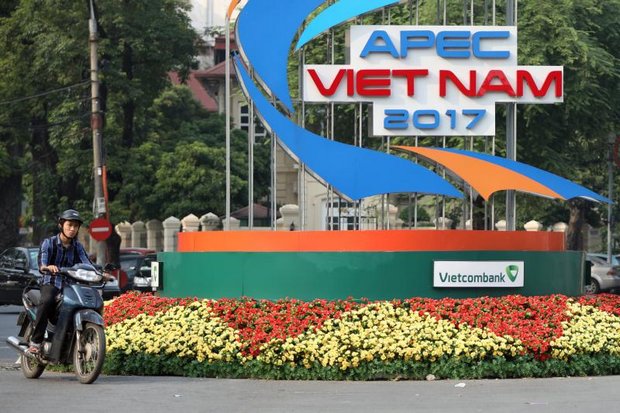
After more than three decades of economic reforms, Vietnam will play host to the Asia-Pacific Economic Cooperation (Apec) Leaders' Meeting in Da Nang on Nov 10-11. Given the rapidly changing world and this dynamic region, the summit has great significance in terms of economic and strategic matters.
Vietnam, which has been preparing for this mega-event for over two years, has four key objectives. First of all, amid the rise of populism and protectionism, the host must seize the moment with Apec leaders to make their cooperative process more effective and efficient. In particular, the summit must embed foundations for sustainable, inclusive and equitable global development.
Secondly, the efforts to reduce trade barriers and increase investment liberalisation must continue as Apec is entering its fourth decade of development. It is still a tall order because there are challenges in dealing with intellectual property rights, and opening e-commerce and service liberalisation.

Kavi Chongkittavorn is a veteran journalist on regional affairs.
Thirdly, to sustain economic growth, Vietnam must use this opportunity to further promote bilateral trade to expand its exports and attract foreign investment. Lest we forget, Vietnam, which has yet to be identified as a market economy, already has one of the largest free-trade networks in Asean, with 17 free-trade arrangements.
Finally, Da Nang is considered Vietnam's most well-known port facility and will be the showcase for future connectivity that links Southeast Asia to the rest of the world. After a long period of anxiety over whether Vietnam is part of China's Belt and Road Initiative (BRI), now it can be said positively that Hanoi is part and parcel of BRI, in addition to existing frameworks of connectivity espoused by Asean and its dialogue partners.
Beyond economic cooperation, the Apec summit also provides a unique opportunity. During US President Donald Trump's visit to Da Nang, Vietnam can showcase the diplomatic finesse which has brought it international recognition. Mr Trump will certainly make his feelings known on the US government's trade strategies and overall Asian policy.
In the past few months, Mr Trump has held bilateral talks with four key Asean members in Washington. Leaders from Vietnam, Malaysia, Thailand and Singapore got strong pledges from Mr Trump of continued US commitment and engagement both in trade and security. In the beginning, his "America First" policy rattled the region, as the US is still the biggest export market for Asean members.
Washington has listed Vietnam, Malaysia and Thailand of having unfair trade practices as they have enjoyed high trade surpluses with the US. During their leaders' visits, they pledged to invest more in the US and import more US products, which are expected to make tens of thousands of jobs for Americans.
In Da Nang, Mr Trump will also have the chance for face-to-face talks with the new paramount leader of China, President Xi Jinping, Russian President Vladimir Putin and other leaders from 20 economies. According to Prof Carlyle Thayer, an expert on Vietnam, it is an ideal situation for Hanoi, because its diplomats have always been adept at playing off differences and convergences in the material interests of major powers. Now that Mr Trump has decided to skip the East Asia Summit, scheduled for Nov 14 at Clark Freeport Zone in the Philippines, the Apec platform and sidelines of the leaders' meeting give added strategic value to the host.
Vietnam will also use the Apec platform to push Washington to display a clearer position on trade and investment liberalisation. Since Mr Trump became president, the US has sent mixed signals on how the world's No.1 economy will engage with other economies. For the region, Washington's withdrawal from the US-led Trans-Pacific Partnership (TPP) was the biggest blow to the US free-trade policy and caused predictions of a future protectionist trend. In fact, as the Apec summit draws near, Washington has already sent out the message that Mr Trump wants fair trade that will benefit everyone, that he is not anti-free trade or anti-globalisation.
Truth be told, after the US pullout from the TPP, among all of the remaining signatories, Hanoi has suffered the most as it tries to reconcile a big imbalance between benefits and responsibilities in the modified agreement. It is understandable why Hanoi showed initial reluctance in supporting the so-called TPP 11, the modified trade deal being re-assessed by the 11 remaining nations in the TPP, eagerly being pushed by Japan, New Zealand and Australia.
As Apec host, Vietnam has no choice but to push the TPP 11 forward. So far, it has held several ministerial meetings on the TPP 11, joining with others to discuss its yet unknown future. Indeed, it was Vietnam that issued a joint statement on its commitment to continue with the TPP 11 and leave open a window of opportunity for the US to come back to the trade accord.
With regard to Vietnam's future plans, Hanoi will seek further commitment on the sidelines of Apec from the members of the TPP 11 that the trade deal should continue even without US participation. After all, this premium free-trade agreement should be pursued for the long-term benefit of the region.
The success of Apec would further enhance Vietnam's leading role at the Asean summit, which will follow hot on its heels at Clark Freeport Zone. Already, Hanoi is preparing for its Asean chairmanship in 2020 to ensure that the group will work in tangible ways to strengthen Asean centrality and external relations, as well as community-building by closing the gap between its old and new members.
